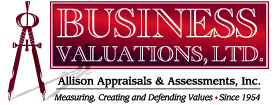Entrepreneurs fear the biggest risk is the one not taken. Ours is often the avoidance of a bad selection, the opposite of which is validation for making a good one. Opportunists see the glass half full. Worriers see the glass half empty. Realists think the glass could be half the size.
Most professions offer products or services to minimize risks or enhance opportunities. A valuation report reflects these risks and opportunities as they are. But at what level(s)?
Interestingly, to solve for the “value” of a business, there are two parts that need to be determined.
(1) What is the economic benefit? (Growth and income/cash flow); and
(2) What is the likelihood (risk) the economic benefit will occur or continue?
While “risk” is the harder factor to identify and measure, +90% of most business valuation reports focus on the economic benefit. Why? Because valuations can often be formulaic instead of relying on deep due diligence and analysis. Yet, courts and regulatory bodies expect a scientific approach (empiricism). For the BV profession, this means mastery of finance as well as legal and operational issues.
What’s the benefit to entrepreneurs? The lower the risks for a company, the higher the price multiple. The higher the price multiple, the higher the value. If a company has $1 million in profits and higher risks, the price multiple might be 3x for a value of $3 million. However, if the risks are lowered, the price multiple might be 5x for a value of $5 million – a $2 million difference. If purchasing risk reduction services and/or products cost $200,000 to achieve the extra $2 million would the 10 to 1 investment be worthwhile? The benefit to trusted advisors to solve for these risks should be evident.
If you’d like to discuss how to identify risk and influence equity value (up or down), please arrange an appointment by clicking here. The Wiley Finance book Equity Value Enhancement (“EVE”) addresses Governance, Relationships, Risks and Knowledge (“GRRK”). Over 100 of the 368 pages discusses these risks in detail. Complimentary Chapter 3 provides summary of 29 risks found in 3,000+ engagements with an incidence of 80% or greater.
Top 29 Operational Risks Found in 3,000+ Business Valuation Engagements (Frequency 80% or more often):
- Meeting minutes are boilerplate (90%).
- No budget or forecasts (80%).
- No performance metrics/nominal knowledge of market/competitors (80%).
- No annual review of insurance (90%).
- No independent and regular independent and qualified valuation (95%).
- No business, marketing, or succession plans (90%).
- No strategy (90%).
- Nominal effort to cull clients (80%).
- No gain-sharing for innovation (90%).
- Culture is control oriented, siloed, and tactical (80%).
- Banking relationship is solely transactional (80%).
- Board comprised of family, inside directors, and friends (95%).
- Limited or no involvement in own or client industry associations (80%).
- Poor knowledge of balance sheet, P&L, or growth norms for industry (90%).
- No shareholder/key person/buy–sell agreements or not followed (80%).
- No risk assessments/SWOT analysis (80%).
- No review of education, experience, age, and health of key personnel (80%).
- Concentration of clients and vendors (80%).
- Little to no leverage of trusted advisors (90%).
- No independent advisory board (95%).
- Little leverage of human capital (knowledge and relationships) (90%).
- No effort to identify, protect, and/or leverage intangible assets (80%).
- Founder, management or advisors have reached capability (80%).
- No review to optimize capital structure (90%).
- No supply chain analysis (90%).
- Nominal cross-training of personnel (80%).
- Nominal redundancy of key functions (80%).
- Little or no training budget (80%).
- Underfunded or unfunded buy–sell agreement (80%).
If you're interested in why I wrote EVE or posts on Governance and Relationships, click on the below. I welcome your thoughts on this or these posts and sharing is always appreciated.
Why I Wrote Equity Value Enhancement (Read Reviews Here)
